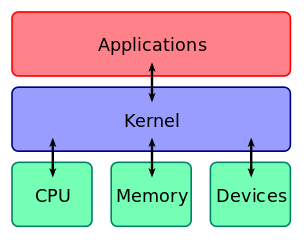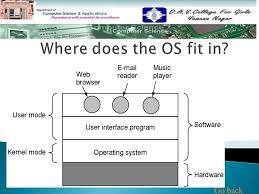Operating Systems: Overview
A Computer System Can be divided into four components: - The Hardware, the Operating system, The Application Programs and a user.
{tocify} $title= {Table
of Contents}
The Hardware- the central processing units (CPU), The memory and the input/output ( I/O) devices – provides the basic computing resources for the systems. The Application Programs- such as word processors, spreadsheets, Compilers and the Web browsers- define the ways in which these resources are used to solve users’ computing problems. The Operating Systems control the hardware and coordinates its use among the various applications for the various users. We can also view a computing system as consisting as hardware, software and data. The operating systems views are user view and system view. These followings are:-
1. User
view:-
The user’s view of the computer varies according to the interface being used. Many computer users sit with a laptop or in front of a pc consisting of a monitor, keyboard, and mouse. Such a system is designed for one user to monopolize its resources. The goal is to maximize the work that the user is performing. In this case, the operating system is designed mostly for ease of use.
 |
Abstract View of Components of a Computer Systems Increasingly, many users interact with mobile devices such
as Smart phones, and tablets- devices that replacing desktop and laptop
computer systems for some user’s .These devices are connected to networks
through cellular or other wireless technologies. The user interface with the
system by touch screen, where the
user interacts with the system by pressing and swiping fingers across the
screen. Than using physical keyboard and mouse. Many mobile devices also allow
user to interact through a voice
recognition interface, such as Apple’s
Siri. Conceptual View So Computers have little or no user view. For example, embedded computers in home devices and automobiles may have numeric keypads and may turn indicator lights on or off to show status, but they and their operating systems and applications are designed primarily to run without intervention. 2. System View:-From the Computer point of view, the operating system is the program most intimately involved with the hardware. In this context, we can view an operating system as resource allocator. A computer system has many resources that may be required to solve a problem: CPU time, memory space, I/O devices, and so on. The operating system acts as the manager of these resources. Facing numerous and possibly conflicts requests for resources, the operating system must decide how to allocate them to specific programs and users so that it can operate the computer system efficiently and fairly. A slightly different view of an operating system emphasizes the need to control the various I/O devices and user programs. An operating system is a control program. A control program manages the execution of user programs to prevent errors and improper use of the computer. It is especially concerned with the operation and control of I/O devices. Most readers will have had some experience with an operating System such as Windows, Linux, FreeBSD, or OS X, but appearances can be deceiving> The program that users interact with usually called the Shell when it is text based and the GUI (Graphical User Interface)-which it pronounced “gooey”- when it uses icons, is actually not part of the operating systems. A simple overview of the main components under discussion here is gen below. Here we see the Hardware at the bottom. The hardware consists if Chips, bounds, disks, a keyboard, a monitor, and similar physical objects. On the top of the Hardware is the Software. Most Computers have two modes of Operation: kernel Hardware and User mode. The operating system, the most fundamental piece of software, runs in kernel mode. In this mode it has complete access to all hardware and can execute any instruction the machine is capable of executing. The rest of the software runs in user mode, in which only a subset of the machine instructions is available. In particular, those instructions that affect control of the machine or do I/O (input /output) are forbidden to user-mode programs. It plays a crucial role in operating systems team work. The difference between Kernel mode and User mode:- An important distinction between the operating system and normal (user - mode) software is that if a user does not like a particular email reader, he or she is free to get a different one or write his own if he so chooses; h is free to write his own clock interrupt handler, which is part of the operating opetating system and is protected by Hardware against attempts by user to modify it. This distinction, however, is something blurred in embedded systems (Which may not have Kernel mode) or interpreted systems (such as java - based systems) that use, interpretation, not hardware, to separate the Components). Also, in many systems there are programs that run in user mode but help the operating system or perform privileged functions. For example, there is often a program that allows user to change their passwords. It is not part of the operating system and does not run in kernel mode, but it clearly carries out a sensitive function and has to be protected in a special way. In some systems, the idea is carried to an extreme, and pieces of what is traditionally considered to be operating system (such as the file system) run in user space. In such systems, it is difficult to draw a clear boundary. Everything running in kernel mode is clearly part of the operating system, but some programs running outside it are arguably also part of it, or at least closely associated with it. Operating Systems differ from user (i.e., application) programs in ways other than where they reside. In particular, they are huge, complex, and long-lived. The source code of the heart of the operating system like Linux or Windows is on the order of five million lines of code or more. To conceive of what this means, think of printing out five million lines in book form, with 50 lines per page and 1000 pages per volume. It would take 100 volumes to list an operating system of the size- essentially an entire bookcase. This operating systems exclude basic application software (things like Windows Explorer, Windows Media Player, and So on). Why operating systems live a long time- they are very hard to write, and having written one, the owner is loath to throw it out and start again. Instead, such systems evolve over long periods of time. Windows 95/98/Me was basically one operating system. Windows NT/ 2000/ XP/Vista/ Windows 7 is different one. They look similar to the users because Microsoft made very sure that the user interface of windows 2000/ XP/ vista/ windows 7 are quite similar to that of the system it was replacing, mostly windows 98. Besides windows, the other is UNIX and its variants and clones. It has evolved over the years like System V, Salaries, FreeBSD being derived from the original system, whereas Linux is a fresh code base, although very closely modeled on UNIX. In This Tutorials we will briefly touch on a number of key aspects of operating systems. 3. Defining operating Systems:-
Now we can see that the term operating System cover many roles and functions. That is the case, t least in part, because of the myriad designs and uses of computers. Computers are present within toasters, cars, ships, space craft, homes, and business. They are the basis for game machine, Cable TV tuners, and industrial control systems. Computer used in fixed purpose use of military system, such as code braking and trajectory plotting, and the government uses, such as census calculation. Those early computers evolved into general –purpose, multifunction mainframes and that’s when operating systems were born. In the 1960s, Moore’s Law predicted that the number of transistors on an integrated circuit would double every 18 months. Computers gained in functionality and shrank in size, leading to a vast number of uses and a vast number and variety of operating Systems. What is operating Systems:-A operating systems exit because they offer a reasonable way to solve the problem of creating a usable computing system. The goal of operating systems is to execute programs and to make solving user problems easier. Computer hardware is constructed toward this goal. Along with hardware is ease to use, application programs are developed. These hardware programs require certain common operations, such as controlling the I/O devices. The common functions of operating system that resource allocating are brought together into one piece of software. Some computer systems take up less than mega bytes of space and lack even a full-screen editor, others require gigabytes of space and are used entirely on graphical windowing systems. A common definition is that the operating system is the one program running at all times on the computer system- usually called the kernel. There are two other types of programs: System programs, which are associated with the operating system not necessarily, part of kernel and application programs, which include not associated with the operating system. Today, if we look at operating systems for mobile devices see that once again the number of features constituting for operating system is increasing. Mobile operating systems often include not only a core kernel but also middle ware- a set of software frameworks that provide services to application developers. For example, each of the most prominent mobile operating systems- Apple’s IOS and Google’s Android – features a core kernel along with middle ware that supports databases, multimedia, and graphics. Summary:-In summary for our purposes, the operating system includes the always running kernel, middleware ware frameworks that ease application development and provide features, and system programs that aid in managing while it is running. Most of this article is concerned with the kernel of general operating systems, but other components are discussed operating system design and specifications. |


